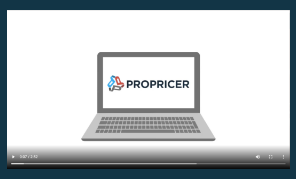“Is there a better way?” If you’re a Contractor or Agency Contract Officer, you’ve no doubt said this to yourself about the current contract pre-award process.
There is. But it takes effort on both the vendor and government sides. A consistent drive to streamline contract pricing usually involves a minimal amount of research, a modicum of compromise, a dedication to good intention, and sometimes a little patience.
We have some ideas. Study the following three pieces of advice for each side of the pricing equation.
On the contractor side
1. See if your Agency client awards on value or price.
Do you really need to be the low price leader? Sometimes you do. In various government divisions, Agencies make awards based strictly on price alone—the lowest price wins, without exception.
Yet, other Agencies are more likely to award contracts to the offeror who creates the best value for the dollars required. An example: Your proposal includes the work of very talented subcontract professionals who are willing to operate at a small discount in order to collaborate with the government, and hopefully lock in future work on other contracts.
Still, other Agencies award contracts based on a combination of both value and pricing. You’ll streamline your contract process exponentially if you can determine in advance where your client Agency falls.
How to do this? Research public-domain contracts. You’ll be able to spot a preferred trend sooner than later.
2. Gain a good idea of expected prices beforehand.
One thing is certain: The Agency you’re dealing with has already gone through the financial gymnastics required to know what a contract will cost before calling for proposals.
This number doesn’t necessarily align with the resultant award number. Why? The Agency has to get early funding for the project from its government higher-ups, as part of its budget process for the year. This is primarily for risk management. By knowing the amount, you can get somewhat close to what you should charge.
That said, here’s some guidance on how to anticipate pricing expectations:
- Study the contract RFP to determine the scope of work and its breakdown structure. This helps you envision the tactical process involved, and its sequence of events. If you don’t have the data to define certain tasks, make your best assumption and put your estimate together—and explain your assumptions in the proposal. Also, clarify why you felt you had to guesstimate. Use tact.
- Put together an employee and subcontractor forecast, so you have a rough idea of the talent you’ll need to fulfill the Agency’s needs. What skill sets? Which vendors? Can you use tried and true talent, or do you need to go outside your comfort zone for special services? Assign a timeline and set number of hours to each person involved. 1
3. Back pricing out of similar, recent contracts.
With even minimal sleuthing, you can usually find contracts that have been previously awarded by your client Agency or similar—along with the related public-domain financial data that maps to each.
Anticipate direct and burdened labor rates for your current RFP, average hourlies, and complete contract price. Conduct research on the U.S. General Services Administration (GSA) site, then map your findings to salary surveys for applicable labor categories.
You can also come up with a bidding strategy that incorporates a perspective on your competition’s wrap rates. 1
On the Agency side
1. Know your Contractor’s approach to pricing.
As an Agency, you’ll be leaps ahead in the contracting game if you can understand your Contractor’s goals.
Study their previous proposals for insight into a specific pricing strategy. Extensive details on pricing typically indicate less wiggle room than in proposals that are more general in treatment. Past Price Negotiation Memorandums (PNMs), as well as insight from your associates who’ve had previous dealings with the Contractor are other valuable sources of information.
As you research, reflect on the Contractor’s priorities and anticipate how they affect pricing. For example, a Contractor’s first goal by answering an RFP may not be to make a huge profit. It may be to enter a new government category, build greater market share in an existing category, or simply re-establish a foothold in continuing government business. By understanding any of these scenarios, you’ll be in a better position to create an Agency win by awarding a current contract more quickly and economically.
2. Aim low but allow for an amount of back-and-forth.
Obviously, the greater value you expect to win from a Contract, the better your Agency team will perform.
Always counter an initial Contractor bid with one that creates a greater advantage for your Agency. But be prepared to make concessions.
Placing your opening position too close to your desired price will leave you less room for flexibility—and that can mean losing out on a highly qualified Contractor, while also having to go back to your shortlist to start final negotiations again.
Net/net: You want your initial price offer to be close to your end goal, but still far enough away for you to make compromises if you have to. 2
3. Remember that patience is a pricing virtue.
Though a streamlined contract award process is the most desirable, impulsive decisions on your Agency’s part can cost you. On the flipside, patience in pricing can smooth out rough Contractor edges, present expectations in a more favorable light, and give your Contractor space to say “yes” to an outcome that might not be their ideal.
While playing a short waiting game may ultimately serve to streamline pricing, if pauses in conversation become too long you can also set decision deadlines that work in your favor. 3
ProPricer helps streamline your pricing process.
Successful contract streamlining is more than just getting your best deal fast. It’s about obtaining a high-value solution for both parties as painlessly as possible.
For both Contractor and Agency, this can lead to quality performance, delivery that’s on-time, and a mutually beneficial long-term relationship. While you should aim to gain a fair price as efficiently as you can, you should also focus on building strong rapport with your other party.
For an easier way to streamline proposals, change orders, and revisions, consider ProPricer - a pricing platform that simplifies proposal pricing development accuracy, submission, evaluation, negotiation, and audits.
Using ProPricer Government Edition or ProPricer Contractor Edition, both Agencies and Contractors can put to work a similar—yet fully compatible—software system to streamline the pricing process.
Ready? Request a live ProPricer demo here.
Sources
1. ProjStream Basis of Estimate Article: 5 Pricing Strategies that Win Government Contracts
2. Defense Acquisition University: Negotiation Techniques Tools Catalog.
3. Watershed Associates Article: Time and Patience in Negotiations





